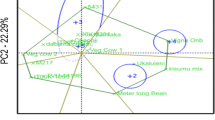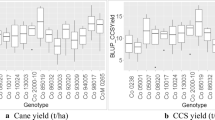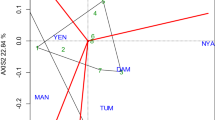Abstract
Cowpea is one of the most important indigenous food and forage legumes in Africa. It serves as a primary source of protein for poor farmers in drought-prone areas of Ethiopia. The crop is used as a source of food, and insurance crop during the dry season. Cowpea is adaptable to a wide range of climatic conditions. Despite this, the yield of the crop is generally low due to lack of stable and drought-tolerant varieties. In this study, 25 cowpea genotypes were evaluated in five environments using a lattice design during the 2017 and 2018 main cropping seasons. The objectives of this study were to estimate the magnitude of genotype by environment interaction (GEI) and grain yield stability of selected drought-tolerant cowpea genotypes across different environments. The additive main effect and multiplicative interaction (AMMI) model indicated the contribution of environment, genotype and GEI as 63.98, 2.66% and 16.30% of the total variation for grain yield, respectively. The IPCA1, IPCA2 and IPCA3 were all significant and explained 45.47%, 28.05% and 16.59% of the GEI variation, respectively. The results from AMMI, cultivar superior measure, genotype plus genotype-by-environment biplot yield stability index, and AMMI stability value analyses identified NLLP-CPC-07-145-21, NLLP-CPC-103-B and NLLP_CPC-07-54 as stable and high yielding genotypes across environments. Thus, these genotypes should be recommended for release for production in drought-prone areas. NLLP-CPC-07-143, Kanketi and CP-EXTERETIS were the least stable. The AMMI1 biplot showed that Jinka was a high potential and favorable environment while Babile was an unfavorable environment for cowpea production.




Similar content being viewed by others
References
Agbicodo EM, Fatokun CA, Muranaka S et al (2009) Breeding drought tolerant cowpea: constraints, accomplishments, and future prospects. Euphytica 167:353–370. https://doi.org/10.1007/s10681-009-9893-8
Ahenkora K, Adu Dapaah HK, Agyemang A (1998) Selected nutritional components and sensory attributes of cowpea (Vigna unguiculata [L.] Walp) leaves. Plant Foods Hum Nutr 52:221–229. https://doi.org/10.1023/A:1008019113245
Bose LK, Jambhulkar NN, Pande K, Singh ON (2014) Use of AMMI and other stability statistics in the simultaneous selection of rice genotypes for yield and stability under direct-seeded conditions. Chil J Agric Res 74:1–9. https://doi.org/10.4067/S0718-58392014000100001
Das A, Parihar AK, Saxena D, Singh D, Singha KD, Kushwaha KPS, Chand R, Bal RS, Chandra S, Gupta S (2019) Deciphering genotype-by-environment interaction for targeting test environments and rust resistant genotypes in field pea (Pisum sativum L). Front Plant Sci 10:825. https://doi.org/10.3389/fpls.2019.00825
De OEJ, Paulo J, Freitas XD, Jesus ON (2014) AMMI analysis of the adaptability and yield stability of yellow passion fruit varieties. Sci Agricola 71:139–145
Diouf D (2011) Recent advances in cowpea [Vigna unguiculata (L.) Walp.] “omics” research for genetic improvement. Afr J Plant Biotech 10:2803–2810. https://doi.org/10.5897/AJBx10.015
Farshadfar E, Mahmodi N, Yaghotipoor A (2011) AMMI stability value and simultaneous estimation of yield and yield stability in bread wheat (Triticum aestivum L.). Aust J Crop Sci 5:1837–1844
Fatokun CA, Boukar O, Muranaka S (2012) Evaluation of cowpea (Vigna unguiculata ( L.) Walp) germplasm lines for tolerance to drought. Plant Genet Resour Charact Util 10:171–176. https://doi.org/10.1017/S1479262112000214
Filho JT, Dos Santos Oliveira CNG, da Silveira LM, de Sousa Nunes GH, da Silva AJR, da Silva MFN (2017) Genotype by environment interaction in green cowpea analyzed via mixed models. Rev Caatinga, Mossoro 30:687–697
Gerrano A, Jansen van Rensburg WS, Mathew I, Shayanowako AIT, Bairu MW, Venter SL, Swart W, Mofokeng A, Mellem J, Labuschagne M (2020) Genotype and genotype × environment interaction effects on the grain yield performance of cowpea genotypes in dryland farming system in South Africa. Euphytica 216:1–11. https://doi.org/10.1007/s10681-020-02611-z
Gomez KA, Gomez AA (1984) Statistical procedures for agricultural research, 2nd edn. John Wiley and Sons Inc., New York, USA
Goufo P, Moutinho-pereira JM, Jorge TF, Correia CM (2017) Cowpea (Vigna unguiculata L. Walp.) metabolomics : osmoprotection as a physiological strategy for drought stress resistance and improved yield. Front Plant Sci 8:1–22. https://doi.org/10.3389/fpls.2017.00586
Hall AE, Cisse N, Thiaw S et al (2003) Development of cowpea cultivars and germplasm by the Bean/Cowpea CRSP. Field Crop Res 82:103–134. https://doi.org/10.1016/S0378-4290(03)00033-9
Hartley O (1950) The maximum F-ratio as a short-cut test for heterogeneity of variance. Biometrika 37:308–312
IBPGR (1983) Cowpea descriptors, 1st edition. international board for plant genetic resources, Rome, Italy
SAS II (2013) Statistical Analysis System, Version 9.4 SAS institute Inc. 476
Jadhav S, Balakrishnan D, Shankar VG, Beerelli K, Chandu G, Neelamraju S (2019) Genotype by environment interaction study on yield traits in different maturity groups of rice. J Crop Sci Biotech 22:425–449. https://doi.org/10.1007/s12892-018-0082-0
Kandus M, Almora D, Ronceros RB, Salerno JCS (2010) Statistical models for evaluating the genotype-environment interaction in Statistical models for evaluating the genotype-environment interaction in maize (Zea mays L.) Modelos estadísticos para evaluar la interacción genotipo-ambiente en maíz (Zea mays). Phyton (B Aires) 79:39–46
Kaya Y, Akçura M, Taner S (2006) GGE-Biplot analysis of multi-environment yield trials in bread wheat. Turkish J Agric for 30:325–337
Kuruma RW, Sheunda P, Muriuki C (2019) Yield stability and farmer preference of cowpea (Vigna unguiculata) lines in semi-arid eastern Kenya. Afrika Focus 32:65–82
Leflon M, Lecomte C, Barbottin A, Jeuffroy MH, Robert N, Brancourt-Hulmel M (2008) Characterization of environments and genotypes for analyzing genotype × environment interaction. J Crop Improv 14:249–298. https://doi.org/10.1300/J411v14n01
Lin CS, Binns MR (1988) A superiority measure of cultivar performance for cultivar x location data. Can J Plant Sci 68:193–198
Marina M, Fernández J, Ochoa J et al (2017) Genotype by environment interactions in cowpea (Vigna unguiculata L. Walp) grown in the Iberian Peninsula. Crop Pasture Sci 68:924–931
Mohammadi R, Amri ÆA (2008) Comparison of parametric and non-parametric methods for selecting stable and adapted durum wheat genotypes in variable environments. Euphytica 159:419–432. https://doi.org/10.1007/s10681-007-9600-6
Muranaka S, Shono M, Myoda T, Takeuchi J (2016) Genetic diversity of physical, nutritional and functional properties of cowpea grain and relationships among the traits. Plant Genet Resour Charact Util 14:67–76. https://doi.org/10.1017/S147926211500009X
Oladosu Y, Rafii MY, Abdullah N, Magaji U, Miah G, Hussin G, Ramli A (2017) Genotype × Environment interaction and stability analyses of yield and yield components of established and mutant rice genotypes tested in multiple locations in Malaysia. Acta Agric Scan 67:590–606. https://doi.org/10.1080/09064710.2017.1321138
Olajide AA, Ilori CO (2017) Effects of drought on morphological traits in some cowpea genotypes by evaluating their combining abilities. Adv Agric 2017:1–10
Owade JO, Abong G, Okoth M, Mwang AW (2020) A review of the contribution of cowpea leaves to food and nutrition security in East Africa. Food Sci Nutr 8:36–47. https://doi.org/10.1002/fsn3.1337
Pacheco A, Vargas M, Alvarado G, Rodriguez F, Crossa J, Burgueno J (2016) User's Manual GEA-R (Genotype by Environment Analysis with R ). GEA-R 1–42
Purchase JL, Hatting H, Van DCS (2000) Genotype × environment interaction of winter wheat (Triticum aestivum L.) in South Africa : I. AMMI analysis of yield performance. South Afr J Plant Soil 17:95–100. https://doi.org/10.1080/02571862.2000.10634877
Simion T (2018) Adaptability performances of cowpea [Vigna unguiculata ( L.) Walp ] genotypes in Ethiopia. Food Sci Qual Manag 72:43–47
Simion T, Mohammed W, Fenta BA (2018) Genotype by environment interaction and stability analysis of cowpea [Vigna unguiculata (L.) Walp] genotypes for yield in Ethiopia. J Plant Breed Crop Sci 10:249–257. https://doi.org/10.5897/JPBCS2018.0753
Singh BB, Ajeigbe HA, Tarawali SA et al (2003) Improving the production and utilization of cowpea as food and fodder. Field Crop Res 84:169–177. https://doi.org/10.1016/S0378-4290(03)00148-5
Timko, M.P. and Singh BB (2008) Cowpea, a multifunctional legume. In: Paul, H. Moore and Ray M (ed) genomics of tropical crop plants, 1st edn. Springer Science+Business Media, LLC, pp 227–258
Tumuhimbise R, Melis R, Shanahan P, Kawuki R (2014) Genotype × environment interaction effects on early fresh storage root yield and related traits in cassava. Crop J 2:329–337. https://doi.org/10.1016/j.cj.2014.04.008
Weng Y, Jun Q, Eaton S, Yang Y, Ravelombola WS, Shi A (2019) Evaluation of seed protein content in USDA cowpea germplasm. HortScience 54:814–817
Yan W (2002) Singular-value partitioning in biplot analysis of multi environment trial data. Agron J 94:990–996. https://doi.org/10.2134/agronj2002.0990
Yan W (2011) GGE Biplot vs. AMMI Graphs for genotype-by-environment data analysis. Journal Indian Soc Agric Stat 65:183–193
Yan W (2016) Analysis and handling of G × E in a practical breeding program. Crop Sci 56:2106–2118. https://doi.org/10.2135/cropsci2015.06.0336
Yan W, Rajcan I (2002) Biplot Analysis of test sites and trait relations of soybean in Ontario. Crop Sci 42:11–20. https://doi.org/10.2135/cropsci2002.0011
Yan W, Tinker NA (2006) Biplot analysis of multi-environment trial data: principles and applications. Can J Plant Sci 86:623–645. https://doi.org/10.4141/P05-169
Yan W, Hunt LA, Sheng Q, Szlavnics Z (2000) Cultivar evaluation and mega-environment investigation based on the GGE biplot. Crop Sci 40:597–605. https://doi.org/10.2135/cropsci2000.403597x
Yan W, Kang MS, Ma B, Woods S, Cornelius PL (2007) GGE biplot vs. AMMI analysis of genotype-by-environment data. Crop Sci 47:643–655. https://doi.org/10.2135/cropsci2006.06.0374
Yaw E, Isaac O, Amegbor K, Mohammed H, Kusi F, Atpkle I, Sie EK, Ishahku M, Zakaria M, Iddrisu S, Kendey HA, Boukar O, Fatokun C, Nutsugah SK (2020) Genotype × environment interactions of yield of cowpea (Vigna unguiculata ( L.) Walp ) inbred lines in the Guinea and Sudan Savanna ecologies of Ghana. J Crop Sci Biotechnol 23:453–460. https://doi.org/10.1007/s12892-020-00054-5
Zali H, Farshadfar E, Sabaghpour SH (2012) Evaluation of genotype × environment interaction in chickpea using measures of stability from AMMI model. Ann Biol Res 3:3126–3136
Zobel RW, Wright MJ, Gauch HG (1988) Statistical analysis of a yield trial. Agron J 80:388–393. https://doi.org/10.2134/agronj1988.00021962008000030002x
Acknowledgements
The authors sincerely acknowledge the contribution of Wolkite University, Melkassa Agricultural Research Center (EIAR), and The McKnight Foundation USA, for providing the research funds to complete this project. The author acknowledges the staff of national lowland pulse improvement program of Melkassa Agricultural Research Center (MARC) is highly appreciated for their comprehensive support.
Funding
This study was supported by The McKnight Foundation, USA through Collaborative Crop Research Program (CCRP) for Ethiopian Agricultural research Institute (EIAR).
Author information
Authors and Affiliations
Contributions
All authors contributed to the study conception and design. Material preparation, data collection and analysis were performed by TWM, FM and BA. The first draft of the manuscript was written by TWM and FM and all authors commented on previous versions of the manuscript. All authors read and approved the final manuscript for publication.
Corresponding author
Ethics declarations
Conflict of interest
The authors declare that they have no conflict of interest.
Additional information
Publisher's Note
Springer Nature remains neutral with regard to jurisdictional claims in published maps and institutional affiliations.
Rights and permissions
About this article
Cite this article
Mekonnen, T.W., Mekbib, F., Amsalu, B. et al. Genotype by environment interaction and grain yield stability of drought tolerant cowpea landraces in Ethiopia. Euphytica 218, 57 (2022). https://doi.org/10.1007/s10681-022-03011-1
Received:
Accepted:
Published:
DOI: https://doi.org/10.1007/s10681-022-03011-1




